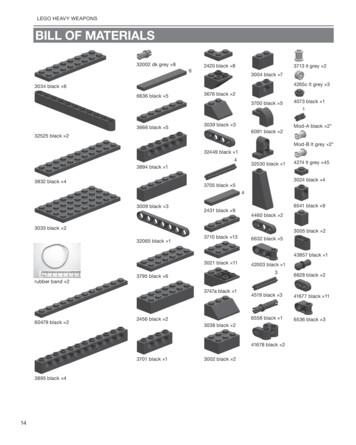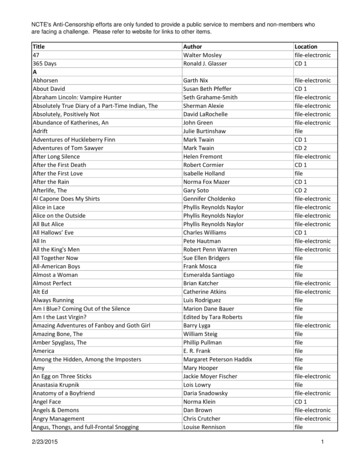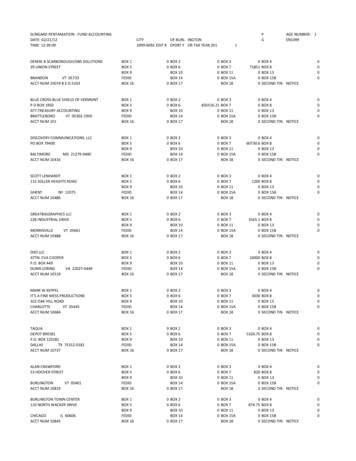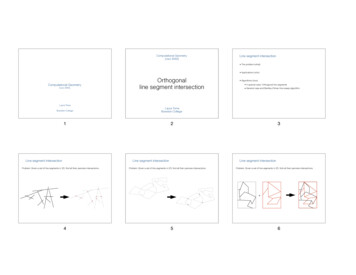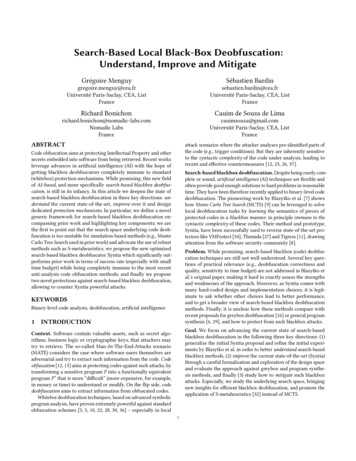
Transcription
Search-Based Local Black-Box Deobfuscation:Understand, Improve and MitigateGrégoire MenguySébastien Bardingregoire.menguy@cea.frUniversité Paris-Saclay, CEA, ListFrancesebastien.bardin@cea.frUniversité Paris-Saclay, CEA, ListFranceRichard BonichonCauim de Souza de Limarichard.bonichon@nomadic-labs.comNomadic LabsFrancecauimsouza@gmail.comUniversité Paris-Saclay, CEA, ListFranceABSTRACTattack scenarios where the attacker analyses pre-identified parts ofthe code (e.g., trigger conditions). But they are inherently sensitiveto the syntactic complexity of the code under analysis, leading torecent and effective countermeasures [12, 25, 26, 37].Code obfuscation aims at protecting Intellectual Property and othersecrets embedded into software from being retrieved. Recent worksleverage advances in artificial intelligence (AI) with the hope ofgetting blackbox deobfuscators completely immune to standard(whitebox) protection mechanisms. While promising, this new fieldof AI-based, and more specifically search-based blackbox deobfuscation, is still in its infancy. In this article we deepen the state ofsearch-based blackbox deobfuscation in three key directions: understand the current state-of-the-art, improve over it and designdedicated protection mechanisms. In particular, we define a novelgeneric framework for search-based blackbox deobfuscation encompassing prior work and highlighting key components; we arethe first to point out that the search space underlying code deobfuscation is too unstable for simulation-based methods (e.g., MonteCarlo Tree Search used in prior work) and advocate the use of robustmethods such as S-metaheuristics; we propose the new optimizedsearch-based blackbox deobfuscator Xyntia which significantly outperforms prior work in terms of success rate (especially with smalltime budget) while being completely immune to the most recentanti-analysis code obfuscation methods; and finally we proposetwo novel protections against search-based blackbox deobfuscation,allowing to counter Xyntia powerful attacks.Search-based blackbox deobfuscation. Despite being rarely complete or sound, artificial intelligence (AI) techniques are flexible andoften provide good enough solutions to hard problems in reasonabletime. They have been therefore recently applied to binary-level codedeobfuscation. The pioneering work by Blazytko et al. [7] showshow Monte Carlo Tree Search (MCTS) [9] can be leveraged to solvelocal deobfuscation tasks by learning the semantics of pieces ofprotected codes in a blackbox manner, in principle immune to thesyntactic complexity of these codes. Their method and prototype,Syntia, have been successfully used to reverse state-of-the-art protectors like VMProtect [34], Themida [27] and Tigress [11], drawingattention from the software security community [8].Problem. While promising, search-based blackbox (code) deobfuscation techniques are still not well understood. Several key questions of practical relevance (e.g., deobfuscation correctness andquality, sensitivity to time budget) are not addressed in Blazytko etal.’s original paper, making it hard to exactly assess the strengthsand weaknesses of the approach. Moreover, as Syntia comes withmany hard-coded design and implementation choices, it is legitimate to ask whether other choices lead to better performance,and to get a broader view of search-based blackbox deobfuscationmethods. Finally, it is unclear how these methods compare withrecent proposals for greybox deobfuscation [16] or general programsynthesis [6, 29], and how to protect from such blackbox attacks.KEYWORDSBinary-level code analysis, deobfuscation, artificial intelligence1INTRODUCTIONGoal. We focus on advancing the current state of search-basedblackbox deobfuscation in the following three key directions: (1)generalize the initial Syntia proposal and refine the initial experiments by Blazytko et al. in order to better understand search-basedblackbox methods, (2) improve the current state-of-the-art (Syntia)through a careful formalization and exploration of the design spaceand evaluate the approach against greybox and program synthesis methods, and finally (3) study how to mitigate such blackboxattacks. Especially, we study the underlying search space, bringingnew insights for efficient blackbox deobfuscation, and promote theapplication of S-metaheuristics [32] instead of MCTS.Context. Software contain valuable assets, such as secret algorithms, business logic or cryptographic keys, that attackers maytry to retrieve. The so-called Man-At-The-End-Attacks scenario(MATE) considers the case where software users themselves areadversarial and try to extract such information from the code. Codeobfuscation [12, 13] aims at protecting codes against such attacks, bytransforming a sensitive program 𝑃 into a functionally equivalentprogram 𝑃 ′ that is more “difficult” (more expensive, for example,in money or time) to understand or modify. On the flip side, codedeobfuscation aims to extract information from obfuscated codes.Whitebox deobfuscation techniques, based on advanced symbolicprogram analysis, have proven extremely powerful against standardobfuscation schemes [3, 5, 10, 22, 28, 30, 36] – especially in local1
Menguy, et al.2 BACKGROUND2.1 ObfuscationContributions. Our main contributions are the following: We refine Blazytko et al.’s experiments in a systematic way,highlighting new strengths and new weaknesses of the initialSyntia proposal for search-based blackbox deobfuscation(Section 4). Especially, Syntia (based on Monte Carlo TreeSearch, MCTS) is far less efficient than expected for smalltime budgets (typical usage scenario) and lacks robustness; We propose a missing formalization of blackbox deobfuscation(Section 4) and dig into Syntia internals to rationalize ourobservations (Section 4.4). It appears that the search spaceunderlying blackbox code deobfuscation is too unstable to relyon MCTS – especially assigning a score to a partial statethrough simulation leads to poor estimations. As a result,Syntia is here almost enumerative; We propose to see blackbox deobfuscation as an optimizationproblem rather than a single player game (Section 5), allowingto reuse S-metaheuristics [32], known to be more robust thanMCTS on unstable search spaces (especially, they do notneed to score partial states). We propose Xyntia (Section 5),an search-based blackbox deobfuscator using Iterated LocalSearch (ILS) [24], known among S-metaheuristics for its robustness. Thorough experiments show that Xyntia keeps thebenefits of Syntia while correcting most of its flaws. Especially, Xyntia significantly outperforms Syntia, synthesizingtwice more expressions with a budget of 1 s/expr than Syntia with 600 s/expr. Other S-metaheuristics also clearly beatMCTS, even if they are less effective here than ILS; We evaluate Xyntia against other state-of-the-art attackers(Section 6), namely the QSynth greybox deobfuscator [16],program synthesizers CVC4 [6] and STOKE [29], and patternmatching based simplifiers. Xyntia outperforms all of them –it finds 2 more expressions and is 30 faster than QSynthon heavy protections; We evaluate Xyntia against state-of-the-art defenses (Section 7), especially recent anti-analysis proposals [14, 25, 31,35, 37]. As expected, Xyntia is immune to such defenses. Inparticular, it successfully bypasses side-channels [31], pathexplosion [25] and MBA [37]. We also use it to synthesizeVM-handlers from state-of-the-art virtualizers [11, 34]; Finally, we propose the two first protections against searchbased blackbox deobfuscation (Section 8). We observe that allphases of blackbox techniques can be thwarted (hypothesis, sampling and learning), we propose two practical methods exploiting these limitations and we discuss them in thecontext of virtualization-based obfuscation: (1) semanticallycomplex handlers; (2) merged handlers with branch-less conditions. Experiments show that both protections are highlyeffective against blackbox attacks.Program obfuscation [12, 13] is a family of methods designed tomake reverse engineering (understanding programs internals) hard.It is employed by manufacturers to protect intellectual propertyand by malware authors to hinder analysis. It transforms a program𝑃 in a functionally equivalent, more complex program 𝑃 ′ with anacceptable performance penalty. Obfuscation does not ensure thata program cannot be understood – this is impossible in the MATEcontext [4] – but aims to delay the analysis as much as possiblein order to make it unprofitable. Thus, it is especially importantto protect from automated deobfuscation analyses (anti-analysisobfuscation). We present here two important obfuscation methods.Mixed Boolean-Arithmetic (MBA) encoding [37] transformsan arithmetic and/or Boolean expression into an equivalent one,combining arithmetic and Boolean operations. It can be appliediteratively to increase the syntactic complexity of the expression.Eyrolles et al. [18] show that SMT solvers struggle to answer equivalence requests on MBA expressions, preventing the automatedsimplification of protected expressions by symbolic methods.Virtualization [35] translates an initial code 𝑃 into a bytecode𝐵 together with a custom virtual machine. Execution of the obfuscated code can be divided in 3 steps (Fig. 1): (1) fetch the nextbytecode instruction to execute, (2) decode the bytecode and findthe corresponding handler, (3) and finally execute the handler. Virtualization hides the real control-flow-graph (CFG) of 𝑃, and reversingthe handlers is key for reversing the VM. Virtualization is notablyused in malware [19, 33].HandlersFetchExecuteℎ 1 (𝑥, 𝑦)ℎ 2 (𝑥, 𝑦)ℎ 3 (𝑥, 𝑦).ℎ𝑛 (𝑥, 𝑦)BytecodesFigure 1: Virtualization based obfuscation2.2DeobfuscationDeobfuscation aims at reverting an obfuscated program back toa form close enough to the original one, or at least to a more understandable version. Along the previous years, symbolic deobfuscation methods based on advanced program analysis techniqueshave proven to be very efficient at breaking standard protections[3, 5, 10, 22, 28, 30, 36]. However, very effective countermeasuresstart to emerge, based on deep limitations of the underlying codelevel reasoning mechanisms and potentially strongly limiting theirusage [3, 25, 26, 31, 35]. Especially, all such methods are ultimatelysensitive to the syntactic complexity of the code under analysis.We hope that our results will help better understand search-baseddeobfuscation, and lead to further progress in this promising field.2.3Search-based blackbox deobfuscationSearch-based blackbox deobfuscation has been recently proposedby Blazytko et al. [7], implemented in the Syntia tool, to learn thesemantics of well-delimited code fragments, e.g. MBA expressionsor VM handlers. The code under analysis is seen as a blackbox thatcan only be queried (i.e., executed under chosen inputs to observeresults). Syntia samples input-output (I/O) relations, then uses aAvailability. Benchmarks and code are available online.1 Additionalexperimental data will be made available in a separate technicalreport.1 WillDecodebe made available2
Search-Based Local Black-Box Deobfuscation:Understand, Improve and MitigateSuch encoding syntactically transforms the expression to makeit incomprehensible while preserving its semantics. To highlightthe difference between syntax and semantics, we distinguish:learning engine to find an expression mapping sampled inputs totheir observed outputs. Because it relies on a limited number ofsamples, results are not guaranteed to be correct. However, beingfully blackbox, it is in principle insensitive to syntactic complexity.(1) The syntactic complexity of expression 𝑒 is the size of 𝑒,i.e. the number of operators used in it;(2) The semantic complexity of expression 𝑒 is the smallestsize of expressions 𝑒 ′ (in a given language) equivalent to 𝑒.Scope. Syntia tries to infer a simple semantics of heavily obfuscatedlocal code fragments – e.g., trigger based conditions or VM handlers.Understanding these fragments is critical to fulfill analysis.For example, in the MBA language, 𝑥 𝑦 is syntactically simplerthan (𝑥 2𝑦) 2 (𝑥 2𝑦) 𝑦, yet they have the same semanticcomplexity as they are equivalent. Conversely, 𝑥 𝑦 is more semantically complex than (𝑥 𝑦) 0, which equals 0. We do not claimto give a definitive definition of semantic and syntactic complexity– as smaller is not always simpler – but introduce the idea that twokinds of complexity exist and are independent.The encoding in Eq. (1) is simple, but it can be repeatedly applied to create a more syntactically complex expression, leading thereverser to either give up or try to simplify it automatically. Whitebox methods based on symbolic execution (SE) [28, 36] and formulasimplifications (in the vein of compiler optimizations) can extractthe semantics of an expression, yet they are sensitive to syntacticcomplexity and will not return simple versions of highly obfuscatedexpressions. Conversely, blackbox deobfuscation treats the code asa blackbox, considering only sampled I/O behaviors. Thus increasing syntactic complexity, as usual state-of-the-art protections do, hassimply no impact on blackbox methods.Workflow. Syntia workflow is representative of search-based blackbox deobfuscators. First, it needs (1) a reverse window i.e., a subset ofcode to work on; (2) the location of its inputs and outputs. Considerthe code in Listing 1 evaluating a condition at line 4. To understand this condition, a reverser focuses on the code between lines1 and 3. This code segment is our reverse window. The reverserthen needs to locate relevant inputs and outputs. The conditionat line 4 is performed on 𝑡3. This is our output. The set of inputscontains any variables (registers or memory locations at assemblylevel) influencing the outputs. Here, inputs are 𝑥 and 𝑦. Armed withthese information, Syntia samples inputs randomly and observesresulting outputs. In our example, it might consider the samples(𝑥 1, 𝑦 2), (𝑥 0, 𝑦 1) and (𝑥 3, 𝑦 4) which respectively evaluate 𝑡3 to 3, 1 and 7. Syntia then synthesizes an expressionmatching these observed behaviors, using Monte Carlo Tree Search(MCTS) over the space of all possible (partial) expressions. Here,it rightly infers that 𝑡3 𝑥 𝑦 and the reverser concludes thatthe condition is 𝑥 𝑦 5, where a symbolic method will typicallysimply retrieve that ((𝑥 2𝑦) 2 (𝑥 2𝑦) 𝑦) 5.1234intintintift1t2t3( t33.3 2 y; x t1 ; t2 2 ( x t1 ) y ; 5 ) . . .We now present how blackbox methods integrate in a global deobfuscation process and highlight crucial properties they must hold.Global workflow. Reverse engineering can be fully automated,or handmade by a reverser, leveraging tools to automate specifictasks. While the deobfuscation process operates on the whole obfuscated binary, blackbox modules can be used to analyze parts ofthe code like conditions or VM handlers. Upon meeting a complexcode fragment, the blackbox deobfuscator is called to retrieve asimple semantic expression. After synthesis succeeds, the inferredexpression is used to help continue the analysis.Listing 1: Obfuscated condition3 MOTIVATION3.1 Attacker modelIn the MATE scenario, the attacker is the software user himself. Hehas only access to the obfuscated version of the code under analysisand can read or run it at will. We consider that the attacker is highlyskilled in reverse engineering but has limited resources in terms oftime or money. We see reverse engineering as a human-in-the-loopprocess where the attacker combines manual analysis with automated state-of-the-art deobfuscation methods (slicing, symbolicexecution, etc.) on critical, heavily obfuscated code fragments likeVM handlers or trigger-based conditions. Thus, an effective defensestrategy is to thwart automated deobfuscation methods.3.2Blackbox deobfuscation in practiceRequirements. In virtualization based obfuscation, the blackboxmodule is typically queried on all VM handlers [7]. As the numberof handlers can be arbitrarily high, blackbox methods need to befast. In addition, inferred expressions should ideally be as simple asthe original non-obfuscated expression and semantically equivalentto the obfuscated expression (i.e., correct). Finally, robustness (i.e.,the capacity to synthesize complex expressions) is needed to beusable in various situations. Thus, speed, simplicity, correctnessand robustness, are required for efficient blackbox deobfuscation.Syntactic and semantic complexityDiscussion. One may argue that local blackbox deobfuscation canbe easily parallelized, limiting the need for fast synthesis. However,reverse engineering is often performed incrementally (e.g., packing,self-modification), or/and with a human in the loop and the needfor quick feedback. In those scenarios, parallelization cannot helpthat much while slow synthesis obstructs analysis. Also, in somecases Syntia fails in 12h (Sections 5.3 and 8.2) – parallelism cannothelp there.We now intuitively motivate the use of blackbox deobfuscation.Consider that we reverse a piece of software protected through virtualization. We need to extract the semantics of all handlers, whichusually perform basic operations like ℎ(𝑥, 𝑦) 𝑥 𝑦. Understandingℎ is trivial, but it can be protected to hinder analysis. Eq. (1) showshow MBA encoding hides ℎ semantics.𝑚𝑏𝑎ℎ(𝑥, 𝑦) 𝑥 𝑦 (𝑥 2𝑦) 2 (𝑥 2𝑦) 𝑦(1)3
Menguy, et al.4UNDERSTAND BLACKBOXDEOBFUSCATIONAlgorithm 1 Search-based blackbox deobfuscation frameworkInputs:𝐶𝑜𝑑𝑒 : code to analyze𝑆𝑎𝑚𝑝𝑙𝑒 : sampling strategy𝐿𝑒𝑎𝑟𝑛 : learning strategy𝑆𝑖𝑚𝑝𝑙𝑖 𝑓 𝑦 : expression simplifierOutput: learned expression or Failure1: procedure Deobfuscate(𝐶𝑜𝑑𝑒, 𝑆𝑎𝑚𝑝𝑙𝑒, 𝐿𝑒𝑎𝑟𝑛)2:𝑂𝑟𝑎𝑐𝑙𝑒 𝑆𝑎𝑚𝑝𝑙𝑒 (𝐶𝑜𝑑𝑒)3:𝑠𝑢𝑐𝑐, 𝑒𝑥𝑝𝑟 𝐿𝑒𝑎𝑟𝑛(𝑂𝑟𝑎𝑐𝑙𝑒)4:if 𝑠𝑢𝑐𝑐 𝑇𝑟𝑢𝑒 then return 𝑆𝑖𝑚𝑝𝑙𝑖 𝑓 𝑦 (𝑒𝑥𝑝𝑟 )5:else return 𝐹𝑎𝑖𝑙𝑢𝑟𝑒We propose a general view of search-based code deobfuscation fitting state-of-the-art solutions [7, 16]. We also extend the evaluationof Syntia by Blazytko et al. [7], highlighting both some previouslyunreported weaknesses and strengths. From that we derive generallessons on the (in)adequacy of MCTS for code deobfuscation, thatwill guide our new approach (Section 5).4.1Problem at handSearch-based deobfuscation takes an obfuscated expression andtries to infer an equivalent one with lower syntactic complexity.Such problem can be stated as following:RQ3 How is synthesis impacted by the set of operators size?Syntia learns expressions over a search space fixed by predefined grammars. Intuitively, the more operators in the grammar, the harder it will be to converge to a solution. We use 3sets of operators to assess this impact.Deobfuscation. Let 𝑒, 𝑜𝑏 𝑓 be 2 equivalent expressions such that𝑜𝑏 𝑓 is an obfuscated version of 𝑒 – note that 𝑜𝑏 𝑓 is possibly muchlarger than 𝑒. Deobfuscation aims to infer an expression 𝑒 ′ equivalent to 𝑜𝑏 𝑓 (and 𝑒), but with size similar to 𝑒. Such problem can beapproached in three ways depending on the amount of informationgiven to the analyzer:4.2.1 Experimental setup. We distinguish the success rate (number of expressions inferred) from the equivalence rate (number ofexpressions inferred and equivalent to the original one). The equivalence rate relies on the Z3 SMT solver [17] with a timeout of 10s.Since Z3 timeouts are inconclusive answers, we define a notion ofequivalence range: its lower bound is the proven equivalencerate (number of expressions proven to be equivalent) while itsupper bound is the optimistic equivalence rate (expressions notproven different, i.e., optimistic proven #timeout). The equivalence rate is within the equivalence range, while the success rate ishigher than the optimistic equivalence rate. Finally, we define thequality of an expression as the ratio between the number of operators in recovered and target expressions. It estimates the syntacticcomplexity of inferred expressions compared to the original ones.A quality of 1 indicates a perfect result: the recovered expressionhas the same size as the target expression.Blackbox We can only run 𝑜𝑏 𝑓 . The search is thus driven bysampled I/O behaviors. Syntia [7] is a blackbox approach;Greybox Here 𝑜𝑏 𝑓 is executable and readable but the semantics of its operators is mostly unknown. The search is driven bypreviously sampled I/O behaviors which can be applied to subpartsof 𝑜𝑏 𝑓 . QSynth [16] is a greybox solution;Whitebox The analyzer has full access to 𝑜𝑏 𝑓 (run, read) andthe semantics of its operators is precisely known. Thus, the searchcan profit from advanced pattern matching and symbolic strategies.Standard static analysis falls in this category.Blackbox methods. Search-based blackbox deobfuscators followthe framework given in Algorithm 1. In order to deobfuscate code,one must detail a sampling strategy (i.e., how inputs are generated),a learning strategy (i.e., how to learn an expression mapping sampled inputs to observed outputs) and a simplification postprocess.For example, Syntia samples inputs randomly, uses Monte CarloTree Search (MCTS) [9] as learning strategy and leverages the Z3SMT solver [17] for simplification. The choice of the sampling andlearning strategies is critical. For example, too few samples couldlead to incorrect results while too many could impact the searchefficiency, and an inappropriate learning algorithm could impactrobustness or speed.Let us now turn to discussing Syntia learning strategy. We showthat using MCTS leads to disappointing performances and giveinsights to understand why.4.2Benchmarks. We consider two benchmark suites: B1 and B2. B12comes from Blazytko et al. [7] and was used to evaluate Syntia.It comprises 500 randomly generated expressions with up to 3arguments, and simple semantics. It aims at representing state-ofthe-art VM-based obfuscators. However, we found that B1 suffersfrom several significant issues: (1) it is not well distributed over thenumber of inputs and expression types, making it unsuitable forfine-grained analysis; (2) only 216 expressions are unique modulorenaming – the other 284 expressions are 𝛼-equivalent, like x yand a b. These problems threaten the validity of the evaluation.We thus propose a new benchmark B2 consisting of 1,110 randomly generated expressions, better distributed according to thenumber of inputs and the nature of operators – see Table 1. Weuse three categories of expressions: Boolean, Arithmetic and MixedBoolean-Arithmetic, with 2 to 6 inputs. Especially, expressions arespread equally between categories to prevent biased results. Each expression has an Abstract Syntax Tree (AST) of maximal height 3. Asa result, B2 is more challenging than B1 and enables a finer-grainedevaluation. Considering such diverse and complex expressions isEvaluation of SyntiaWe extend Syntia evaluation and tackle the following questions leftunaddressed by Blazytko et al. [7].RQ1 Are results stable across different runs?This is desirable due to the stochastic nature of MCTS;RQ2 Is Syntia fast, robust and does it infer simple and correct results?Syntia offers a priori no guarantee of correctness nor quality.Also, we consider small time budget (1s), adapted to humanin-the-loop scenarios but absent from the initial evaluation;2 amples/mba/tigress4
Search-Based Local Black-Box Deobfuscation:Understand, Improve and Mitigatecrucial as blackbox deobfuscation evolves in an adversarial contextwhere limitations can be exploited to thwart analysis.Note that we also consider QSynth datasets [16] in Section 6,developed by the Quarkslab R&D company.Type#Expr.over Full, Expr and Mba. Smaller sets do exhibit higher successrates (42% on Mba) but results remain disappointing. Syntia issensitive to the size of the operator set but is inefficient even with Mba.Conclusion. Syntia is stable, correct and returns simple results. Yet,it is heavily impacted by the time budget and lacks robustness. It thusfails to meet the requirements given in Section 3.3.# Table 1: Distribution of samples in benchmark B2To ensure the conclusions given in Section 4.4 apply to MCTSand not only to Syntia, we study Syntia extensively to find betterset ups for the following parameters: simulation depth, SA-UCTvalue (configuring the balance between exploitative and explorativebehaviors), number of I/O samples and distance. Optimizing Syntiaparameters slightly improves its results which stay disappointing(at best, 50% of success rate on Mba in 60 s/expr.).Operator sets. Table 2 introduces three operator sets: Full, Exprand Mba. We use these to evaluate sensitivity to the search spaceand answer RQ3. Expr is as expressive as Full even if Expr Full.Mba can only express Mixed Boolean-Arithmetic expressions [37].Table 2: Sets of operatorsFull : { 1, , , , , 𝑢 , 𝑠 , , , , , 𝑠 , 𝑢 , %𝑠 , %𝑢 , }Expr : { 1, , , , , , , , 𝑠 , 𝑢 , }Mba : { 1, , , , , , , }Conclusion. By default, Syntia is well configured. Changing itsparameters lead in the best scenario to marginal improvement, hencethe pitfalls highlighted seem to be inherent to the MCTS approach.Configuration. We run all our experiments on a machine with 6Intel Xeon E-2176M CPUs and 32 GB of RAM. We evaluate Syntia inits original configuration [7]: the SA-UCT parameter is 1.5, we use50 I/O samples and a maximum playout depth of 0. We also limitSyntia to 50,000 iterations per sample, corresponding to a timeoutof 60s per sample on our test machine.4.4Monte Carlo Tree Search. MCTS creates here a search tree whereeach node is an expression which can be terminal (e.g. 𝑎 1, where𝑎 is a variable) or partial (e.g. 𝑈 𝑎, where 𝑈 is a non-terminalsymbol). The goal of MCTS is to expand the search tree smartly,focusing on most pertinent nodes first. Evaluating the pertinence ofa terminal node is done by sampling (computing here a distancebetween the evaluation of sampled inputs over the node expressionagainst their expected output values). For partial nodes, MCTSrelies on simulation: random rules of the grammar are applied tothe expression (e.g., 𝑈 𝑎 ; 𝑏 𝑎 ) until it becomes terminal andis evaluated. As an example, let {(𝑎 1, 𝑏 0), (𝑎 0, 𝑏 1)}be the sampled inputs. The expression 𝑏 𝑎 (simulated from 𝑈 𝑎)evaluates them to (1, 1). If the ground-truth outputs are 1 and 1,the distance will equal 𝛿 (1, 1) 𝛿 (1, 1) where 𝛿 is a chosen distancefunction. We call the result the pertinence measure. The closer it isto 0, the more pertinent the node 𝑈 𝑎 is considered and the morethe search will focus on it.RQ1. Over 15 runs, Syntia finds between 362 and 376 expressionsof B1 i.e., 14 expressions of difference (2.8% of B1). Over B2, it findsbetween 349 and 383 expressions i.e., 34 expressions of difference(3.06% of B2). Hence, Syntia is very stable across executions.RQ2. Syntia cannot efficiently infer B2 ( 34% success rate). Moreover, Table 3 shows Syntia to be highly sensitive to time budget.More precisely, with a time budget of 1 s/expr., Syntia only retrieves16.3% of B2. Still, even with a timeout of 600 s/expr., it tops at 42%of B2. In addition, Syntia is unable to synthesize expressions withmore than 3 inputs – success rates for 4, 5 and 6 inputs respectivelyfalls to 10%, 2.2% and 1.1%. It also struggles over expressions using a mix of Boolean and arithmetic operators, synthesizing only21% (see Table 4). Still, Syntia performs well regarding quality andcorrectness. On average, its quality is around 0.60 (for a timeout of60 s/expr.) i.e., resulting expressions are simpler than the original(non obfuscated) ones, and it rarely returns non-equivalent expressions – between 0.5% and 0.8% of B2. We thus conclude that Syntiais stable and returns correct and simple results. Yet, it is not efficientenough (solves only few expressions on B2, heavily impacted by timebudget) and not robust (number of inputs and expression type).Table 3: Syntia depending on the timeout per expression (B2)1s10s60s600s16.5%16.3%0.3525.6%25.1 - 25.3%0.4934.5%33.7 - 34.0%0.59MCTS for deobfuscationLet us explore whether these issues are related to MCTS.4.2.2 Evaluation Results. Let us summarize here the outcome ofour experiments.Succ. RateEquiv. RangeMean Qual.Optimal SyntiaAnalysis. This simulation-based pertinence estimation is not reliablein our code deobfuscation setting. We present in Fig. 2, for different non-terminal nodes, thedistance values computed through simulations. We observethat from a starting node, a random simulation can returndrastically different results. It shows that the search space isvery unstable and that relying on simulation is misleading(especially in our context where time budget is small); Moreover, our experiments show that in practice Syntia isnot guided by simulations and behaves almost as if it were anenumerative (BFS) search – MCTS where simulations are noninformative. As an example, Fig. 3 compares how the distanceevolves over time for Syntia and a custom, fully enumerative,MCTS synthesizer: both are very similar. Actually, Syntiaand enumerative MCTS perform similarly over B2: with a60s (resp. 600s) timeout, enumerative MCTS reaches 41.4%42.3%41.4 - 41.6%0.67RQ3. Default Syntia synthesizes expressions over the Full set ofoperators. To evaluate its sensitivity to the search space we run it5
Menguy, et al.5Logarith. dist. from (𝑎 𝑏) (𝑏 𝑐)(resp. 51.6%) success rate vs. 42.6% (resp. 54.9%) for Syntia(Mba operators set); Finally, on B2 (resp. B1) with a timeout of 60s, only 34/341(resp. 20/376) successfully synthesized expressions are thechildren of previously most promising nodes. It shows thatSyntia successfully synthesized expressions due to its exploratory (i.e., enumerative) behavior rather than to the selection of nodes according to their pertinence.180016001400120010008006004002000We define a new search-based blackbox deobfuscator, dubbed Xyntia, leveraging S-metah
Goal. We focus on advancing the current state of search-based blackbox deobfuscation in the following three key directions: (1) generalize the initial Syntia proposal and refine the initial experi-ments by Blazytko et al. in order to better understand search-based blackbox methods, (2) improve the current state-of-the-art (Syntia)
